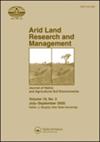Vegetation quality and its change in the Three North Shelterbelt Forest region in China
IF 1.6
4区 农林科学
Q3 ENVIRONMENTAL SCIENCES
引用次数: 0
Abstract
AbstractThe Three North Shelterbelt Forest (TNSF) region in northern China is the largest artificial afforestation area in the world. Vegetation quality in the TNSF region has been improved greatly in recent years. This article presents a new approach to characterize vegetation quality by coupling vegetation productivity and coverage, examining the trend of vegetation quality from 2000 to 2021 at 1 km × 1 km spatial resolution by the linear regression trend method, and analyzing the driving forces of that trend. The results revealed a significant spatial difference of vegetation quality. Higher vegetation quality was found in the east and southeast of the TNSF region. Improvement of vegetation quality was found in approximately 80% area of the TNSF region, at a rate of 0 ∼ 52 g C m−2yr−1 with α = 0.05 significance between 2000 and 2021. Vegetation quality deteriorated in a few areas. The increase in CO2 concentrations and annual precipitation facilitated the improvement of vegetation quality, but also human efforts in ecological protection and restoration accelerated the improvement of vegetation quality under the current climate change background. The results might contribute to designing future ecological projects and the scientific adjustment of vegetation restoration strategies.Keywords: Climate changeecological conservationecosystem Three-North Shelter Forest (TNSF)vegetation quality AcknowledgmentsThe author thanks the National Meteorological Information Center and the Resource and Environmental Science Data Center of the Chinese Academy of Sciences for their data support.Disclosure statementNo potential conflict of interest was reported by the authors.Additional informationFundingThis research was funded by National Key R&D Program of China (2021YFB3901103).中国三北防护林植被质量及其变化
摘要中国北方三北防护林区是世界上最大的人工造林区。近年来,TNSF地区的植被质量得到了很大的改善。本文提出了一种耦合植被生产力和覆盖度表征植被质量的新方法,采用线性回归趋势法对2000 - 2021年1 km × 1 km空间分辨率的植被质量趋势进行了研究,并分析了这种趋势的驱动力。结果表明,植被质量存在显著的空间差异。东部和东南部植被质量较高;2000 - 2021年间,约80%的TNSF区域的植被质量以0 ~ 52 g C m−2yr−1的速率改善,α = 0.05显著性。少数地区植被质量下降。CO2浓度的增加和年降水量的增加促进了植被质量的改善,但在当前气候变化背景下,人类对生态保护和恢复的努力也加速了植被质量的改善。研究结果可为未来生态工程的设计和植被恢复策略的科学调整提供参考。关键词:气候变化生态保护生态系统三北防护林植被质量致谢感谢国家气象信息中心和中国科学院资源与环境科学数据中心的数据支持。披露声明作者未报告潜在的利益冲突。本研究资助国家重点研发计划项目(2021YFB3901103)。
本文章由计算机程序翻译,如有差异,请以英文原文为准。
求助全文
约1分钟内获得全文
求助全文
来源期刊

Arid Land Research and Management
环境科学-环境科学
CiteScore
3.80
自引率
7.10%
发文量
23
审稿时长
9 months
期刊介绍:
Arid Land Research and Management, a cooperating journal of the International Union of Soil Sciences , is a common outlet and a valuable source of information for fundamental and applied research on soils affected by aridity. This journal covers land ecology, including flora and fauna, as well as soil chemistry, biology, physics, and other edaphic aspects. The journal emphasizes recovery of degraded lands and practical, appropriate uses of soils. Reports of biotechnological applications to land use and recovery are included. Full papers and short notes, as well as review articles and book and meeting reviews are published.
 求助内容:
求助内容: 应助结果提醒方式:
应助结果提醒方式:


